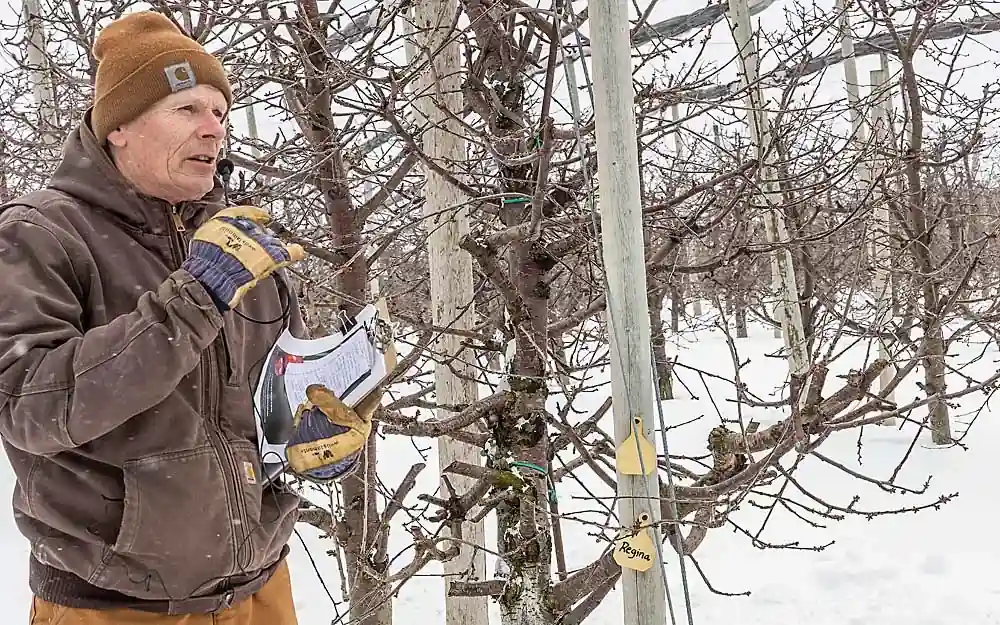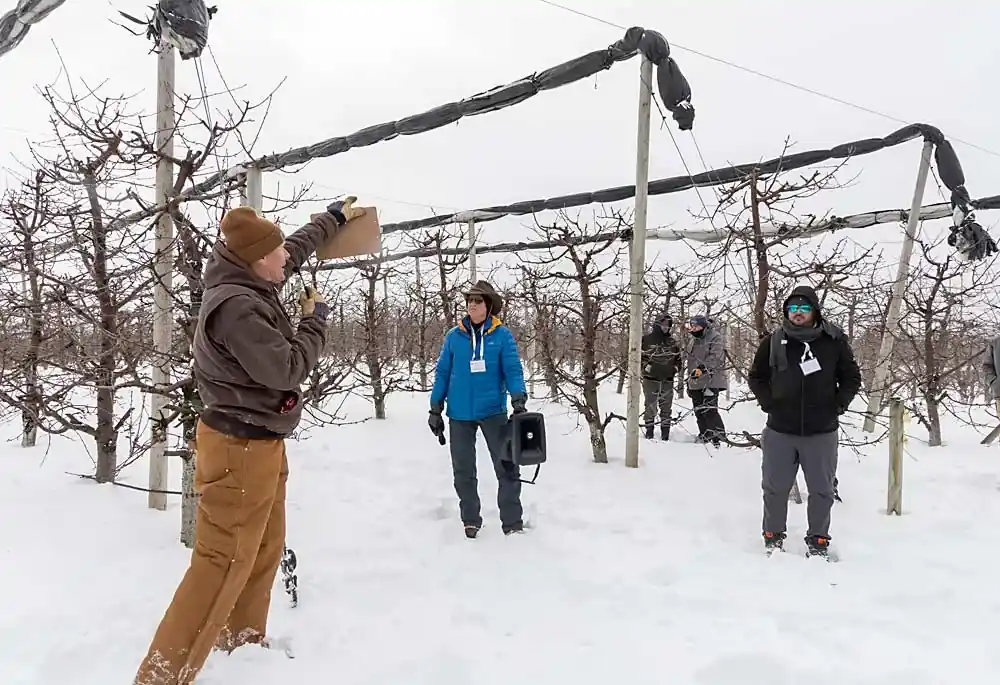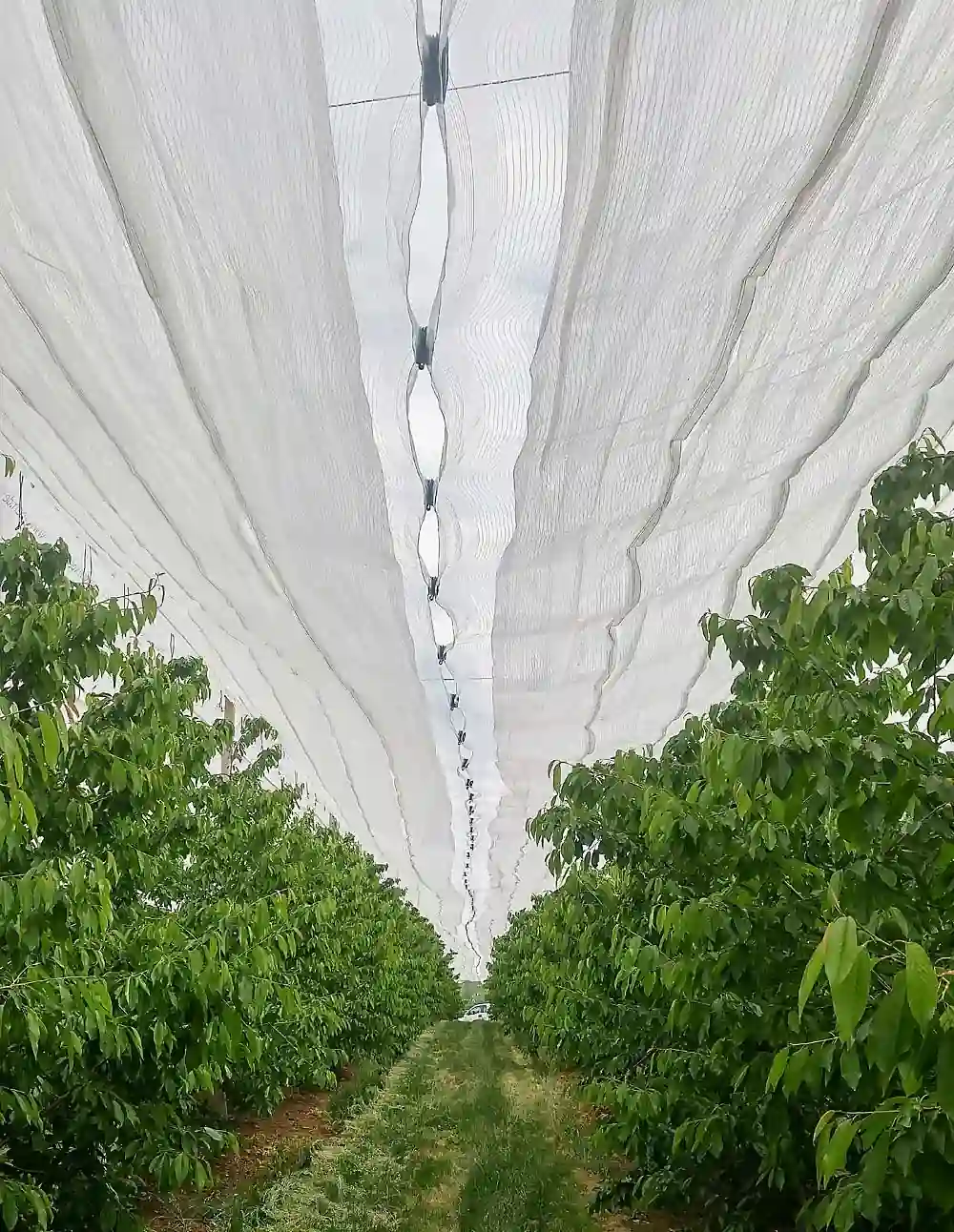In the heart of New York State, where apples dominate the orchards, a grower is defying the odds by investing in sweet cherries thanks to innovative covers and high-density plantings.
During the winter tour of the International Fruit Tree Association (IFTA), mostly dedicated to apples, one stop turned the spotlight on a rarer crop for the region: sweet cherries. The spotlight was on Tim Buhr, grower at Newroyal Orchards in Niagara County, who has found a sustainable way to develop the local cherry industry.
At his farm, Buhr grows 315 acres (about 127 hectares) of apples, 40 acres (16 hectares) of pears, and 20 acres (8 hectares) of sweet cherries, which he sells to a network of 45 clients including local supermarkets, roadside stands, and Amish buyers in Ohio. The goal? Get to market as early as possible, when prices are still high.
“We’re not big players in the cherry market,” Buhr admitted to the tour attendees. “It’s just another crop we can raise.”
 Image 1. Grower Tim Buhr shows IFTA visitors a block of covered sweet cherries (in season) during the February winter tour of Western New York. He said high-density sweet cherries can be profitable but are hard to grow. (Matt Milkovich/Good Fruit Grower)
Image 1. Grower Tim Buhr shows IFTA visitors a block of covered sweet cherries (in season) during the February winter tour of Western New York. He said high-density sweet cherries can be profitable but are hard to grow. (Matt Milkovich/Good Fruit Grower)
German technology and Cornell varieties to tackle Eastern climate
In 2011, Buhr planted a cherry block with 8x17-foot spacing (2.4x5.2 meters), choosing varieties like Regina, Benton, Burgundy Pearl, and Ebony Pearl, grafted on Gisela 6 rootstock. To protect them from above, he installed a modular cover system developed by the German company VOEN in 2014, supported by a trial in collaboration with Cornell University.
The structure, costing about $20,000 (roughly €18,400) per acre, proved essential to reducing hail and rain-induced cracking — events increasingly frequent in wet years. However, after ten years, the plastic and nylon are showing their age, and the labor required to open and close the covers adds to the costs.
“We’ll probably use them for one more season,” Buhr stated, “but with current cherry prices, it’s hard to justify the replacement investment.”
 Image 2. Buhr told IFTA visitors that his VOEN covers have been in use for about a decade and are nearing the end of their life. He said the covers offer good protection against hail and rain but are expensive. (Matt Milkovich/Good Fruit Grower)
Image 2. Buhr told IFTA visitors that his VOEN covers have been in use for about a decade and are nearing the end of their life. He said the covers offer good protection against hail and rain but are expensive. (Matt Milkovich/Good Fruit Grower)
Strategic pruning and research: the key to productivity
According to Cornell fruit physiologist Terence Robinson, covers help growers achieve better yields over time by improving fruit quality and protection. While New York’s humid climate isn’t ideal for fresh-market cherries, new varieties, dwarfing rootstocks, and protective systems have opened up new possibilities for high-density orchards, which now cover about 1,500 acres (roughly 607 hectares) of sweet cherries in the state.
Robinson emphasized that Gisela rootstocks perform very well in humid climates, yielding more than the more vigorous Mazzard and Mahaleb. However, high-density training systems, such as tall spindle or vertical offshoots, require constant renewal pruning to ensure consistent fruiting.
Buhr has adjusted his practices following Cornell’s advice: he now prunes in summer to reduce the risk of bacterial canker, leaving 6–8 inch stubs to protect the trunk. Each year, his workers remove large limbs to allow light penetration and stimulate lower canopy production.
 Image 3. The VOEN cover system was fully deployed on a block of sweet cherries during the growing season at Tim Buhr’s Newroyal Orchards in Niagara County, New York. (Tim Buhr)
Image 3. The VOEN cover system was fully deployed on a block of sweet cherries during the growing season at Tim Buhr’s Newroyal Orchards in Niagara County, New York. (Tim Buhr)
Targeted agronomic management for “challenging” varieties
Among his agronomic strategies, Buhr uses the growth regulator ReTain to enhance fruit set, especially for shy-setting varieties like Regina. “I don’t want to make a thousand passes,” he explained. “One application at popcorn stage, when the central flowers bloom, is enough.”
To complete his approach, Buhr protects his trees with copper-based fungicides, irrigates with drip systems, and supplies nitrogen to manage vigor. At planting, he painted the trunks white to prevent sunburn on hot days.
His goal is ambitious yet feasible: at least 5 tons of cherries per acre (around 12.3 tons per hectare) — a threshold that, if the weather cooperates, can turn a niche crop into a key element of agricultural diversification in New York State.
A replicable model
Tim Buhr’s story shows how innovation, research, and resilience can open up new opportunities even for crops considered marginal. In a context of climate change and margin pressure, Newroyal Orchards’ experience offers a concrete example of how sweet cherries can carve out their place, protected by nets, supported by science, and driven by passion.
Source: goodfruit.com
Header image source: Good Fruit Grower
Cherry Times - All rights reserved















